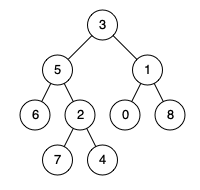Given the root of a binary tree and two integers p and q, return the distance between the nodes of value p and value q in the tree.
The distance between two nodes is the number of edges on the path from one to the other.
Example 1:
Input: root = [3,5,1,6,2,0,8,null,null,7,4], p = 5, q = 0 Output: 3 Explanation: There are 3 edges between 5 and 0: 5-3-1-0.
Example 2:
Input: root = [3,5,1,6,2,0,8,null,null,7,4], p = 5, q = 7 Output: 2 Explanation: There are 2 edges between 5 and 7: 5-2-7.
Example 3:
Input: root = [3,5,1,6,2,0,8,null,null,7,4], p = 5, q = 5 Output: 0 Explanation: The distance between a node and itself is 0.
Constraints:
- The number of nodes in the tree is in the range
[1, 104]. 0 <= Node.val <= 109- All
Node.valare unique. pandqare values in the tree.
# Definition for a binary tree node.
# class TreeNode:
# def __init__(self, val=0, left=None, right=None):
# self.val = val
# self.left = left
# self.right = right
class Solution:
def findDistance(self, root: Optional[TreeNode], p: int, q: int) -> int:
def lca(root, p, q):
if root is None or root.val in [p, q]:
return root
left = lca(root.left, p, q)
right = lca(root.right, p, q)
if left is None:
return right
if right is None:
return left
return root
def dfs(root, v):
if root is None:
return -1
if root.val == v:
return 0
left, right = dfs(root.left, v), dfs(root.right, v)
if left == right == -1:
return -1
return 1 + max(left, right)
g = lca(root, p, q)
return dfs(g, p) + dfs(g, q)/**
* Definition for a binary tree node.
* public class TreeNode {
* int val;
* TreeNode left;
* TreeNode right;
* TreeNode() {}
* TreeNode(int val) { this.val = val; }
* TreeNode(int val, TreeNode left, TreeNode right) {
* this.val = val;
* this.left = left;
* this.right = right;
* }
* }
*/
class Solution {
public int findDistance(TreeNode root, int p, int q) {
TreeNode g = lca(root, p, q);
return dfs(g, p) + dfs(g, q);
}
private int dfs(TreeNode root, int v) {
if (root == null) {
return -1;
}
if (root.val == v) {
return 0;
}
int left = dfs(root.left, v);
int right = dfs(root.right, v);
if (left == -1 && right == -1) {
return -1;
}
return 1 + Math.max(left, right);
}
private TreeNode lca(TreeNode root, int p, int q) {
if (root == null || root.val == p || root.val == q) {
return root;
}
TreeNode left = lca(root.left, p, q);
TreeNode right = lca(root.right, p, q);
if (left == null) {
return right;
}
if (right == null) {
return left;
}
return root;
}
}/**
* Definition for a binary tree node.
* struct TreeNode {
* int val;
* TreeNode *left;
* TreeNode *right;
* TreeNode() : val(0), left(nullptr), right(nullptr) {}
* TreeNode(int x) : val(x), left(nullptr), right(nullptr) {}
* TreeNode(int x, TreeNode *left, TreeNode *right) : val(x), left(left), right(right) {}
* };
*/
class Solution {
public:
int findDistance(TreeNode* root, int p, int q) {
TreeNode* g = lca(root, p, q);
return dfs(g, p) + dfs(g, q);
}
TreeNode* lca(TreeNode* root, int p, int q) {
if (!root || root->val == p || root->val == q) return root;
TreeNode* left = lca(root->left, p, q);
TreeNode* right = lca(root->right, p, q);
if (!left) return right;
if (!right) return left;
return root;
}
int dfs(TreeNode* root, int v) {
if (!root) return -1;
if (root->val == v) return 0;
int left = dfs(root->left, v);
int right = dfs(root->right, v);
if (left == -1 && right == -1) return -1;
return 1 + max(left, right);
}
};/**
* Definition for a binary tree node.
* type TreeNode struct {
* Val int
* Left *TreeNode
* Right *TreeNode
* }
*/
func findDistance(root *TreeNode, p int, q int) int {
var lca func(root *TreeNode, p int, q int) *TreeNode
lca = func(root *TreeNode, p int, q int) *TreeNode {
if root == nil || root.Val == p || root.Val == q {
return root
}
left, right := lca(root.Left, p, q), lca(root.Right, p, q)
if left == nil {
return right
}
if right == nil {
return left
}
return root
}
var dfs func(root *TreeNode, v int) int
dfs = func(root *TreeNode, v int) int {
if root == nil {
return -1
}
if root.Val == v {
return 0
}
left, right := dfs(root.Left, v), dfs(root.Right, v)
if left == -1 && right == -1 {
return -1
}
return 1 + max(left, right)
}
g := lca(root, p, q)
return dfs(g, p) + dfs(g, q)
}
func max(a, b int) int {
if a > b {
return a
}
return b
}
